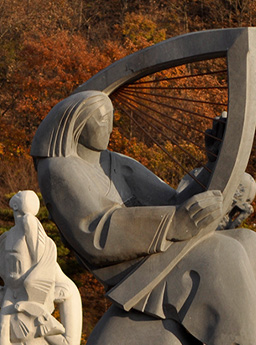Mosan Art Museum
Seongju-myeon, Boryeong-si, in which the Mosan Art Museum is situated, is a major area for producing ‘Oseok,’ which is also called the “Oseok of Nampo,” and ‘Cheongseok’ (bluestone). ‘Oseok’ is used as a tombstone material, while ‘Cheongseok’ is used as an ink stone material. The stones produced here have been widely recognized for their top quality, which has contributed to the growth of the stone industry in the region. The name ‘Oseok’ is derived from its black color, but because it can produce various colors depending on the processing method, it is a suitable material for tombstones and artistic sculptures. ‘Cheongseok’ is almost the same as ‘oseok’ but only has a dark blue color. Since it does not absorb water, it keeps ink from drying too fast once made into an inkstone. Its fine material also makes it easier to sculpt. Therefore, ‘Nampo ink stone’ whose lid is sculpted into various shapes was once the best kind of inkstone highly sought after by the "Seonbi” (scholar) during the Joseon period.
Since its opening, the Mosan Art Museum has created its own original content called “Nampo Oseok,” and strives to help revitalize local arts and culture centering on this content. The museum discovers and nurtures local artists who bring their originality and devotion to their research works. Also, by instilling creativity in them, the museum supports and helps them to play a crucial role in the creation of a new culture and arts.
Furthermore, the museum is running the World Cultural Art Symposium (WCAS) and WCAS Mosan International Sculpture Residency Program, where artists are invited from both home and abroad to exchange their cultural and artistic insights and get to know one another. Through the program, the museum aims to disseminate the region’s local art and culture and become a center for the growth of local culture and arts, equipped with a global perspective and a competitive advantage.
We make sure that the efforts being made at the museum will ultimately allow the residents in this region, which can be considered a culturally underserved area, to enjoy a variety of cultural and artistic experiences and get to experience the products of global art and cultural trends.

